Chocolate??
Everybody knows chocolates...
But I don't think you know chocolates can appeared in fashion shows...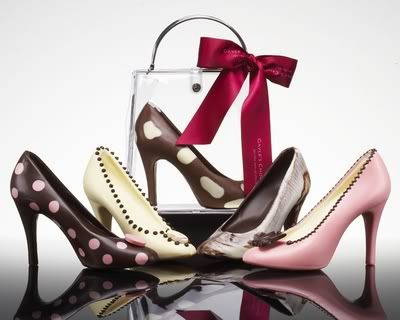
Chocolate or high heeled??It's chocolate heeled shoes!!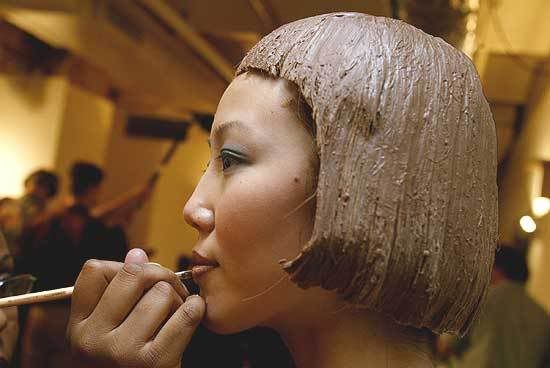
I can't believe this!!Chocolate hairstyle!!??Eww!!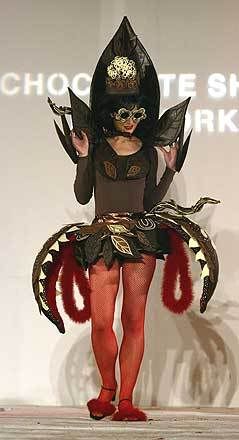
A model walks down the runway wearing a chocolate inspired dress called Little Shop of Horrors by chef Martin Howard.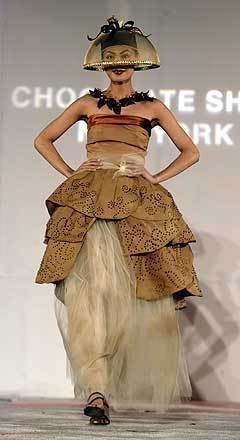
A model walks down the runway wearing a chocolate inspired dress called Chocolate Chai by chefs Colleen Apte and Steve Klc.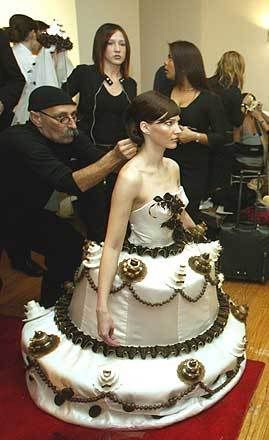
Designers help models into their chocolate outfits before the show.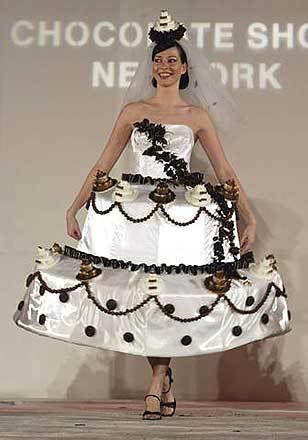
A model walks down the runway wearing a chocolate inspired dress by chef Larry Ebel.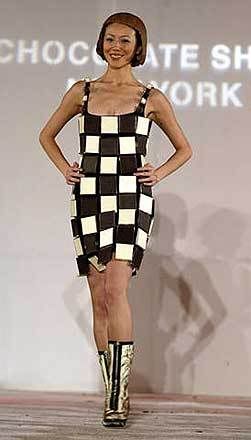
A model walks down the runway wearing another of chef Larry Ebel's chocolate creations.
History of chocolate
The history of chocolate is very diverse from its naming to its creation.
Etymology
The name chocolate most likely comes from the Nahuatl language, indigenous to central Mexico, although it may have been influenced by the Mayan languages. One popular theory is that it comes from the Nahuatl word xocolatl (IPA /ʃo.ko.latɬ/) derived from xocolli, bitter, and atl, water.[1] (Xocolatl was a chocolate drink consumed by the Aztecs, associated with the Mayan god of Fertility). Alternate derivations include that of the Mexican philologist, Ignacio Davila Garibi, who proposed that "Spaniards had coined the word by taking the Maya word chocol and then replacing the Maya term for water, haa, with the Aztec one, atl." The Maya verb chokola'j, "to drink chocolate together", has also been suggested as an origin.[2]. However, Micheal D. Coe, professor Emeritus of Anthropology and Curator Emeritus in the Peabody Museum of Natural History at Yale University, and coauthor of the book The True History of Chocolate (ISBN-0500282298), argues that the word xocolatl appears in "no truly early source on the Nahuatl language or on Aztec culture."
Recently, linguists Karen Dakin and Søren Wichmann found that in many dialects of Nahuatl, the name is 'chicolatl', rather than 'chocolatl'. In addition, many languages in Mexico, such as Popoluca, Mixtec and Zapotec, and even languages spoken in the Philippines have borrowed this form of the word. The word chicol-li, refers to the frothing or beating sticks still used in some areas in cooking. There are two different sticks used, either a small straight stick with small strong twigs on one end, or a stiff plant stalk with the stubs of roots cleaned and trimmed. Since chocolate was originally served ceremonially with individual beater sticks, Dakin and Wichmann argue that it seems quite likely that the original form of the word was 'chicolatl', which would have meant 'beaten drink'. In many areas of Mexico, 'chicolear' means 'to beat, stir'.[3]
Origins
The chocolate residue found in several jars from the site of Puerto Escondido in Honduras, from around 1100 B.C. is the earliest evidence to date of the use of cacao. Slightly later, around 600-400 B.C. there are traces from jars in Belize. The Aztecs associated chocolate with Xochiquetzal, the goddess of fertility. In the New World, chocolate was consumed in a bitter and spicy drink called xocoatl, often seasoned with vanilla, chile pepper, and achiote, (which we know today as annatto). Xocoatl was believed to fight fatigue, a belief that is probably attributable to the theobromine content. Chocolate was an important luxury good throughout pre-Columbian Mesoamerica, and cocoa beans were often used as currency. Other chocolate drinks combined it with such edibles as maize gruel (which acts as an emulsifier) and honey.
The xocolatl was said to be an acquired taste. Jose de Acosta, a Spanish Jesuit missionary who lived in Peru and then Mexico in the later 16th century, wrote of it:
Loathsome to such as are not acquainted with it, having a scum or froth that is very unpleasant to taste. Yet it is a drink very much esteemed among the Indians, where with they feast noble men who pass through their country. The Spaniards, both men and women, that are accustomed to the country, are very greedy of this Chocolaté. They say they make diverse sorts of it, some hot, some cold, and some temperate, and put therein much of that "chili"; yea, they make paste thereof, the which they say is good for the stomach and against the catarrh.[cite this quote]
Christopher Columbus brought some cocoa beans to show Ferdinand and Isabella of Spain, but it was Hernán Cortés who introduced it to Europe more broadly.
The first recorded shipment of chocolate to the Old World for commercial purposes was in a shipment from Veracruz to Sevilla in 1585. It was still served as a beverage, but the Europeans added sugar and milk to counteract the natural bitterness and removed the chilli pepper, replacing it with another Mexican indigenous spice, vanilla. Improvements to the taste meant that by the 17th century it was a luxury item among the European nobility.
Raimundo Madrazo's Hot Chocolate.
At the end of the 18th century, the first form of solid chocolate was invented in Turin by Doret. This chocolate was sold in large quantities from 1826 by Pierre Paul Caffarel. In 1819, F. L. Cailler opened the first Swiss chocolate factory. In 1828, Dutchman Coenraad Johannes van Houten patented a method for extracting the fat from cocoa beans and making powdered cocoa and cocoa butter. Van Houten also developed the so-called Dutch process of treating chocolate with alkali to remove the bitter taste. This made it possible to form the modern chocolate bar. It is believed that the Englishman Joseph Fry made the first chocolate for eating in 1847, followed in 1849 by the Cadbury brothers.
Daniel Peter, a Swiss candle maker, joined his father-in-law's chocolate business. In 1867, he began experimenting with milk as an ingredient. He brought his new product, milk chocolate, to market in 1875. He was assisted in removing the water content from the milk to prevent mildewing by a neighbour, a baby food manufacturer named Henri Nestlé. Rodolphe Lindt invented the process called conching, which involves heating and grinding the chocolate solids very finely to ensure that the liquid is evenly blended.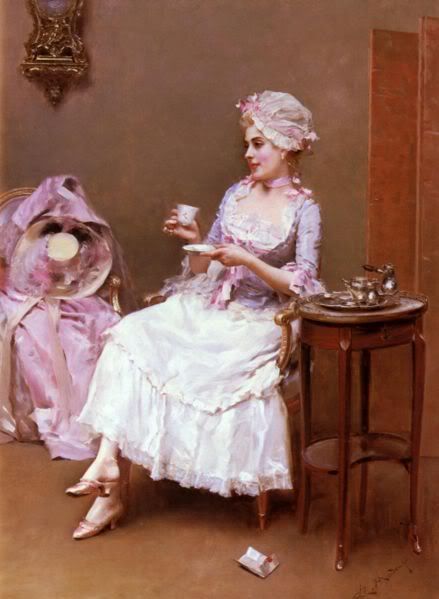
Want some hot chocolate?
Chocolatte!!
- Sunday, November 11, 2007
Subscribe to:
Post Comments (Atom)






3 comments:
Yum...Chocolate...
OH MY LORD.
FOOD!~
You Have the BEST food blog ever.
and by saying this i am ignoring that little avatar on the right that features LV bags.
hahahahaha.
karyoke here btw. =)
Thanks karyoke...you don't really have to tell me i'm having the best blog ever...I wanna be humble...hehe
Post a Comment